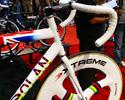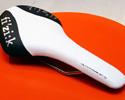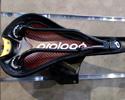

|

|
 |

|

|

|

|
 |
 |

|
 |
 |
 |
Interbike show
Las Vegas, USA, September 22-26, 2008
Main Page Previous Part Next Part
Part 17 - October 15: Road gear explosion in '09
By James Huang
Revamped road line from BH for 2009

|
BH’s bread-and-butter Connect carbon road chassis hasn’t been around for all that long but nevertheless it will get a complete redesign for 2009. According to BH, the tube-to-tube frame gets new size-specific shapes that include a ‘C’-shaped down tube borrowed from the top-end G4, for better lateral rigidity and a cleaner appearance thanks to the concealed cabling. Also borrowed from the G4 is its 320g, all-carbon fork.
What hasn’t changed on the new Connect, however, is its somewhat unusually short 400mm-long chain stays, which BH says yields better drivetrain response. Claimed frame weight for the new Connect is also unchanged from 2008, and still stands at an impressive 900g.
New for 2009 is a women’s-specific version of the Connect called Cristal. The Cristal will use the same fork, high-modulus fibre content, and tube-to-tube construction as the Connect but with curvier, smaller-diameter cross sections to better suit the anticipated lighter rider weights and category-specific frame geometry. Not surprisingly, BH will cover the Cristal in a choice of metallic pink or sky blue hues.
BH also brings a new aero frame to market for 2009 with its revamped Global Concept Aero. The GC Aero bears a variety of now-common wind-cheating trickery such as airfoil tube profiles, deep wheel cutouts on both the seat tube and dropped down tube, and internally routed cables that enter the frame behind the stem.
According to BH, though, the GC Aero also includes an intentionally long head tube that it feels provides a better fit to a majority of consumers who would otherwise have to run an unusually long steerer tube with lots of headset spacers, both of which can compromise overall handling feel due to excess flex. More fitting options come courtesy of the adjustable seatpost which will also provide 75, 76, and 78 degree positions to suit both time trial and triathlon disciplines.
As if that weren’t enough, BH launched a new carbon ‘cross frame at this year’s Interbike show that will also come with a full-carbon fork.
The new Connect and Cristal will both be available to US consumers around November, with the GC Aero coming shortly thereafter; other markets should see them around late January.
New shades of Blue

|
Blue Competition Cycles has upped its aero game with the new Triad time trial/triathlon frame. As opposed to its earlier aluminum-carbon machines, the Triad is an all-carbon construct that looks decidedly more slippery.
Of particular interest are the new ‘Power-Arc’ chain stays which remind us somewhat of the new Scott Plasma and Specialized Transition. The stays remain mostly horizontal aft of the bottom bracket shell before taking a sharp curve up to the rear hub. According to Blue, this creates a ‘wind shadow’ for the rear derailleur and cassette.
Blue also mounts the Tektro rear brake behind and below the bottom bracket shell and the internally routed cables tuck into the top tube behind the stem. A 1" front end helps to keep things narrow and a three-position head atop the integrated seat mast can be adjusted for 76-80 degree effective seat tube angles.
In contrast, the new Blue RD1 road bike sits at the other end of the pricing spectrum with a retail price of less than US$2,000 for a complete build. Blue says the enthusiast-level carbon frame incorporates a bit more vertical compliance than its full-on race rigs, while a slightly taller head tube also makes for a more upright riding position.
The quality spec includes a range of parts from both Shimano and FSA, plus wheels from American Classic and a variety of cockpit components from house brand Aerus. Claimed weight for the complete bike is under 8.2kg (18.0lb).
UK builder Dolan heads for US shores

|
Acclaimed UK framebuilder Terry Dolan isn’t making an enormous marketing splash on US shores just yet but from the sounds of things, that may just be how he prefers it. While many other company booths were awash with eye-catching show special paint jobs and the like, the setup of US importer DPM Sports showcased far more subdued builds bearing simple black-and-white livery with a strong tendency toward track disciplines. Hell, virtually none of the bikes even bore model designations!
Even so, it was hard not to notice the revamped Arc II DF3 which Dolan says is lighter and stiffer than its Arc predecessor. Changes include a more heavily reinforced front triangle, thicker-walled chain stays, and more convenient round seatpost interface and built-in rear dropout adjusters.
According to Dolan, the Arc II DF3 can be built up for pursuit or track purposes with equal aplomb; just swap out a few key components and you’re off to the races. Claimed frame weight is 1690g for a 53cm frame and Dolan will offer the Arc II DF3 in five sizes.
Dolan will also offer three carbon road models: the smooth-riding Tuono and the race-ready Hercules and Aurora, the latter of which will include the currently en vogue integrated seat mast.
fi’zi:k introduces new saddle profile with Antares

|
Up until now, fi’zi:k road saddles have mostly fallen into one of two camps: the long, lean and firm Arione with its flat front-to-back shape and peaked side-to-side profile, or the cushier Aliante for those looking for more of a traditionally-shaped saddle.
Fi’zi:k now introduces a third shape with its new Antares. The Antares is flat fore-aft like the Arione, but is also rather flat side-to-side, much like many Selle Italia models. Although impressively light at just 145g or 175g with braided carbon or k:ium rails, respectively, the Antares is also equipped with a deceptively generous amount of padding, particularly in the flat and broad nose.
The ‘flat in both directions’ theme also carries over to fi’zi:k’s new Tundra cross-country racing saddles. These bear some familial resemblance to the road-going Arione but are flatter side-to-side and also incorporate a much flatter and broader nose.
Padding is definitely on the stiff side and the Wing Flex feature is eliminated entirely though, so if the shape doesn’t suit you at the outset, your opinion isn’t likely to change much moving forward. The carbon-railed Tundra weighs just 199g while the k:ium railed version adds only 20g.
Prologo saddles move out of the pro peloton and into your garage

|
Prologo saddles have surged in popularity in the professional ranks but American buyers have sometimes had a hard time locating one to purchase. That is likely to change now with Prologo’s new distributor, Veltec Sports, which will bring just about the entire catalogue to US shores.
Heading the lineup for 2009 are the Scratch Nack and Scratch models which blend traditional shapes with modern construction and materials. The Scratch Nack uses a full carbon fibre composite base and carbon rails mated to dense foam padding for an ultralight 158g end result.
Unfortunately, that cushy feel and feathery weight also carries a hefty US$419.99 price tag, but those looking to save a few dollars can opt for the standard Scratch instead. Prologo swaps the carbon rails for titanium and gains 24g in the process here but the price also takes a significant drop to US$329.99.
Riders looking for a flatter perch can choose the Nago and Nago Pas instead. Both use a firmer carbon reinforced base that limits applied pressure to the sit bones more than the Scratch while the Nago Pas is also fitted with a cutout. Foam padded version range in weight from 187-195g; gel padding adds about 30-40g.
Prologo also acknowledges off-road riders with its Vertigo line. The top-end Vertigo Nack is essentially the dirt-loving analogue to the Scratch Nack with its full composite base and carbon rails. It’s a touch shorter and wider, though, and more generous padding in the nose brings the weight up to 168g. Retail price is a similarly premium US$419.99.
Photography
For a thumbnail gallery of these images, click here
Images by BH Bicycles
- The new BH Global Concept Aero frame is naturally claimed to be slippery in the wind but BH also says it's easier to fit to more riders.
Images by James Huang/Cyclingnews.com
- BH has completely revamped its Connect road frame with new tube profiles all around.
- The Connect all-round racer borrows its 320g all-carbon fork from the top-end G4.
- BH also introduced a new women's-specific model called the Cristal which is an analogue to the Connect.
- A curved top tube adds a bit of style but also a bit of vertical flex.
- BH will also add a new 'cross frame to its lineup.
- Included in the new cyclo-cross frame is an all-carbon fork.
- How light can you build a BH G4? How does 5.2kg (11.5lb) sound?
- BH built the show special G4 with Edge Composites' new shallow tubular rim…
- …and a set of DT Swiss hubs along with a CNC-machined aluminum cassette.
- In contrast to the Connect, BH builds the Speedrom with modular monocoque construction.
- BH equips the Speedrom with a new all-carbon fork for 2009.
- Blue ups its time trial ante with the new carbon fiber Triad.
- The sleek frame features a tight rear triangle and an integrated seat mast.
- The internally routed cables on the Triad enter the frame through the top tube behind the 1" fork.
- The rear brake on the Triad is mounted behind and below the bottom bracket.
- Blue's new RD1 will reportedly come in below US$2000 complete with its respectable build kit from FSA, Shimano and American Classic.
- Blue says the RD1 will provide a more comfortable ride than its other race-ready machines.
- UK builder Terry Dolan brings his new Arc II DF3 track machine to US shores for 2009.
- The new rear end includes an easier-to-use round seatpost interface and beefier chain stays.
- Redesigned dropouts now include built-in adjusters and stainless steel protective inserts.
- The Dolan stand included a wealth of aero machines including the Aria and Stryke models.
- The Dolan Champion provides track racers on a budget with a triple-butted alloy frame and Terry Dolan's proven track geometry know-how.
- The Dolan name also makes its way on to the road with the Hercules, Tuono and Aurora (not shown) carbon frames.
- This bike definitely stood out amongst the sea of black and white in the Dolan/DPM Sports booth at Interbike.
- Terry Dolan built this bike for Bradley Wiggins complete with a taller head tube to cut down on front end flex.
- The down tube is ovalized to make the most of the available real estate at the bottom bracket shell.
- Who says steel forks are dead? Wiggins seemed to do quite well on this one.
- The new fi'zi:k Antares saddle marks the third major shape from the Italian company.
- As compared to the Aliante and Arione, the Antares is markedly flatter in profile from side-to-side.
- The carbon reinforced shell offers firm support and also skips out on fi'zi:k's trademark Wing Flex feature.
- The new Tundra cross-country race saddle is essentially the off-road version of the Arione.
- The top-end Tundra Carbon reportedly weighs just 199g but buyers beware: it's an awfully firm perch.
- The new dual:tape from fi'zi:k provides a unique look.
- Prologo is set to make a big push on to US shores with a new distributor, Veltec Sports.
- The top-end Scratch Nack uses a flexible carbon fiber shell and carbon rails to yield a final claimed weight of just 158g.
- The more economical Scratch Pro uses the same shape as the Scratch Nack…
- …but trades the carbon shell and rails for a more conventional nylon base and solid titanium rails.
- Riders looking for a flatter shape can also opt for the Prologo Nago.
- A partially cut-out shell provides some relief up front.
- The Prologo C.One30 is just (about) that: 134g of carbon fiber for both the shell and rails.
- The Vertigo Nack is basically the off-road analogue to the road-going Scratch Nack.
- The carbon fiber shell and rails bring the weight of the Vertigo Nack down to just 168g.
- Waterford outdid itself with this musically-themed frame.
- Waterford beautifully integrated both treble and bass clef shapes to the lugwork on this beauty.
- No, you're not seeing things. It's the neck of a guitar.
- Just in case there were any questions what the theme was here, Waterford included this stainless steel guitar right on the seat tube.
- Quarq has expanded the range of cranksets compatible with its innovative Cinqo power meter for 2009.
- The Cinqo power meter can be used with Quarq's own Qranium head or with the iBike Aero or Garmin Edge 705 computers.